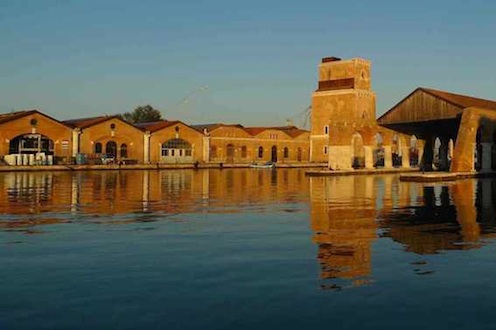
The basis of the design workshop was an examination of the still abandoned parts of Arsenale in Venice. The area, which until recently, was still used by the military, is gradually being assimilated into the city. Great discrimination needed to be taken with this absorption. The city of Venice has an incredibly distinct character, and any changes must take into consideration the qualities of what is there in combination with the needs and technology of the Twenty-First century: pastiche is not an option!
The Arsenale itself is an impressive and complex cluster of boatyards, armories, and wet and dry docks, assembled around two large harbours, all of which is protected by high brick walls. It was responsible for the bulk of Venice’s naval power during the middle part of the second millennium AD. It was one of the earliest large-scale industrial enterprises in history. Even Dante was impressed by the sheer presence of the place:
As in the Arsenal of the Venetians

Boils in winter the tenacious pitch

To smear their unsound vessels over again

For sail they cannot; and instead thereof

One makes his vessel new, and one recaulks

The ribs of that which many a voyage has made

One hammers at the prow, one at the stern

This one makes oars and that one cordage twists

Another mends the mainsail and the mizzen…
As always, we started with a thorough examination of the site, its surroundings and what can only be described as a Venetian coach trip; our own personal Vaporetto ride around the islands of the Lagoon. The visits were accompanied by a series intense lectures and talks by the curators of the sites. The passion of the conservation architect can not be overestimated; the enthusiasm that they held for their subject and the remains in their custody was inspirational.
The group of students was divided into small inter-nationality group, each containing one student from each institution. This inevitably initially caused much tension. The problem of language, difference in approach and differing priorities will create anxiety and disagreement, but it also encourages cooperation, understanding, compassion and eventually synergy. And so it was here, initial distrust was gradually replaced by firm friendship. There was a great amount of professional support for the workshop, and this involvement included the architects and conservators to the Arsenale, structural engineers, architects, conservation architects, as well as two or three academics from each participating university, almost an embarrassment of riches
The students were encouraged to analyse the qualities of each place before attempting to make changes. They looked particularly at the context, that is the history, topography, geology, the very nature of the place. From this analysis they developed an understanding of how the place could be activated. They needed to feel confident that the proposals that they were making were totally appropriate to the qualities of the sites. The students all worked hard to produce proposals of great quality and worth. They endeavoured satisfy all of the often conflicting demands of the conservators, users, consultants and academics, but what was created were truly context driven proposals, which explored the relationships between the water, the buildings, the climate and the place.
This is the fourth collaboration that CiA have made with IUAV, and the second with Granada. Every year the students work incredibly hard, they put in long hours in the studio and then always an enjoyable night in the squares, bars and restaurants of Venice. And again, this year all of them embraced the project with enthusiasm and plenty of intellectual inquiry, and all were a credit to their own institution and the project. Everyone travelled an enormous distance; physically, intellectually and emotionally. The manner in which architecture is taught and discussed varies from one institution to another and certainly there were often great divides between the approaches of each nationality, but of course, there were also great similarities. This was a project that served to bring together the North and South of Europe. It showed how a love for storytelling combined with an understanding of history and technology could bind together a group of disparate and distinct individuals into a forceful united team. This was a project that ventured to create something appropriate, distinct and contemporary from the variously eccentric approaches of our enormous continent.
The design proposals can be viewed here:
